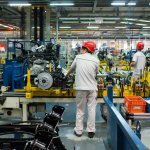
China needs more doctors, but AI can help make medicine more accessible. Source: Shutterstock
AI brings big opportunities for healthcare businesses in China
“THE GREATEST challenge in China is that we have a huge population with poor access to medical services,” Distinguished Chinese Oncology Researcher and Professor Youlin Qiao with nearly 600 research papers to his name and 3 decades on the field told Tech Wire Asia.
Youlin has been working with companies such as Tencent to solve that problem using technology, primarily artificial intelligence (AI) and cloud computing, and has recently announced a breakthrough democratizing cervical cancer diagnostics.
“Our AI solution can help screen for cervical cancer quickly and more efficiently, and in the future, can make assistants more capable so that those with poor access to medical services can also get better care,” YouTu Lab Medical AI Scientist Zheng Yefeng said at Tencent’s Global Digital Ecosystem Summit recently.
Zheng’s solution is one of a kind, but it is also indicative of a new trend in the country (and the world), where AI solutions are either taking over some of the basic, routine, or repetitive tasks of medical specialists or adding to their capabilities to make them faster.
Several technology giants, startups, and even financial services and insurance companies are getting into the healthcare-technology space to create smart solutions using AI.
Youlin points out that creating such AI solutions requires a phenomenal amount of data — which contrary to popular belief — companies in China don’t necessarily have.
“Training medical AI needs data. In the case of building this cervical cancer detection tool, we needed high-quality scans that were labeled correctly. We need data that has a high degree of confidence. It’s not that easy to collect,” said Youlin.
This is precisely the reason that a lot of intelligent businesses in China are constantly working on labeling data, arranging unstructured data into structured tables, and harmonizing data from different sources.
It requires a lot of manpower, time, and energy, and Chinese companies seem to be investing in this activity to build smart medical AI solutions.
Like Youlin mentioned initially, China has fewer doctors than it needs.
Although the government aims to have nearly 300,000 general practitioners by 2020, it’ll still be only 0.2 family doctors for every 1,000 people in the country — far fewer than most developed countries. Australia, for example, has just over 1.5 doctors per 1,000 people and the UK has nearly 1 doctor per 1,000 people.
With technology augmenting the capabilities of its doctors, better medical care might be made more easily available to Chinese residents, especially those in rural and semi-urban regions.
According to a recent IDC report, APAC healthcare IT spending is forecast to increase from US$12.2 billion this year to US$14.9 billion by 2022.
The report also mentions that China and Australia lead the game and account for 71 percent of the total IT spending.
The takeaway for healthcare and healthcare technology businesses, therefore, is that there’s a great opportunity for AI-powered solutions, in China and around the APAC.
Since medical fraternity is already working on creating new tools to better support patients, there’s low overall resistance to new solutions in this field — an important point that can help drive the adoption of AI and other emerging technologies.
READ MORE
- The criticality of endpoint management in cybersecurity and operations
- Ethical AI: The renewed importance of safeguarding data and customer privacy in Generative AI applications
- How Japan balances AI-driven opportunities with cybersecurity needs
- Deploying SASE: Benchmarking your approach
- Insurance everywhere all at once: the digital transformation of the APAC insurance industry






